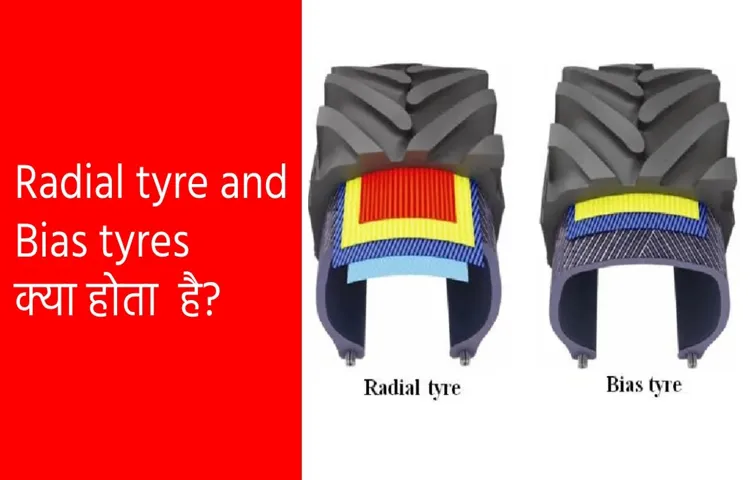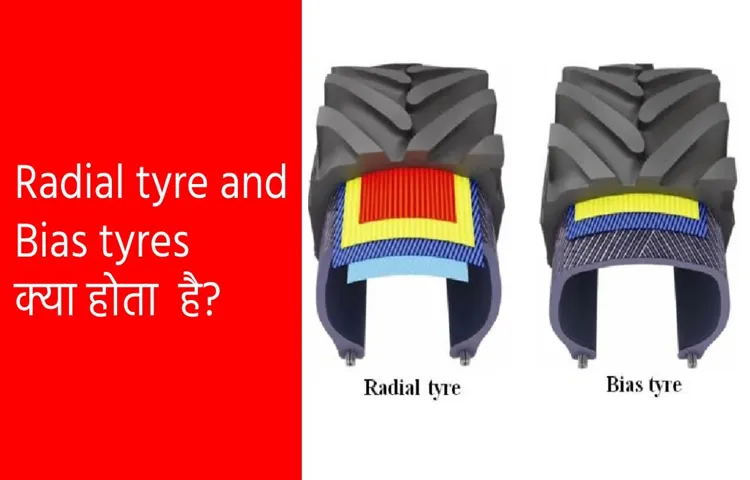Are you having trouble identifying radial and bias tires? Well, fear not, as we’re here to provide you with a comprehensive guide on how to tell them apart. Tires play a crucial role in the overall performance of your vehicle, and it’s essential to have the right type for your needs. Radial and bias tires differ in their construction and design, and knowing their characteristics can help you make an informed decision when it comes to buying new tires or replacing your old ones.
So, buckle up, and let’s dive into the world of tires.
Table of Contents
Physical Differences
If you want to know whether a tire is radial or bias, there are some physical differences that you can look out for. Radial tires have a more flexible sidewall, which helps to improve the ride quality and handling of the vehicle. The belts in a radial tire run across the tire from bead to bead, which creates a smoother contact patch with the road.
On the other hand, bias tires have a more rigid sidewall and a diagonal tread pattern. They’re often used for heavy-duty applications because they can handle more weight, but they don’t offer the same level of performance as radial tires. To tell if a tire is radial or bias, you can look at the sidewall markings.
Radial tires will usually have an “R” followed by a number, such as “R15”. Bias tires will typically have a “B” followed by a number, such as “B15”.
Structure of Bias Tires
One significant difference between bias tires and radial tires is the physical structure. Bias tires have cords that run diagonally from bead to bead, while radial tires have cords that run at a 90-degree angle to the direction of travel. This diagonal structure of bias tires gives them a more flexible and stronger sidewall, allowing them to carry heavy loads.
One way to understand the physical structure of bias tires is to compare it to a woven basket. Just as the cords of a basket go over and under each other, the cords of a bias tire cross over each other at an angle. The result is a tire that can handle the weight and stress of heavy loads, making them popular for use on construction equipment, tractors, and other farm vehicles.

Structure of Radial Tires
Radial tires have a very different physical structure than their predecessor, bias-ply tires. The main difference between the two is in the composition of the layers that make up the tire. Radial tires have one or more layers of steel cord running perpendicular to the direction of travel, known as the “radial” direction.
This creates a stronger and more stable structure, making the tire more resistant to wear and tear and better able to handle heavier loads. In contrast, bias-ply tires have layers of fiber cords running diagonally across the tire, which makes them more flexible but also less durable. Additionally, radial tires have a wider contact area with the road, which means they can run at lower inflation pressures.
This increases traction and improves handling, making radial tires an excellent choice for both performance and safety. Whether you’re driving on the highway or on a race track, radial tires provide the stability and grip you need to stay in control.
Visual Cues
When it comes to determining if a tire is radial or bias, there are a few visual cues you can look for. Radial tires tend to have a smoother, more uniform appearance with sidewalls that are perpendicular to the tread. Bias tires, on the other hand, have a somewhat more rugged appearance with diagonal ply construction visible on the sidewalls.
Another way to tell is by inspecting the tread pattern. Radial tires typically have a wider, flatter surface area, while bias tires usually have a more rounded tread pattern. While it can be challenging to differentiate between these two types of tires, these visual cues can help you determine which type you are dealing with.
It is, however, important to consult with a professional if you are uncertain about the type of tires you have to ensure your safety on the road.
Tread Pattern
When it comes to choosing the perfect tire for your vehicle, the tread pattern is a crucial factor to consider. The tread pattern determines the tire’s ability to grip the road surface in different weather conditions. Visual cues on the tread pattern can give you an idea of its performance capabilities before you make a purchase.
A more aggressive pattern, such as one with large, deep grooves, indicates better traction on wet and slippery surfaces. On the other hand, a tire with a smoother, more shallow tread pattern is better suited for dry conditions. When you’re shopping for tires, pay attention to the patterns on the tire’s surface and take note of the widths of the channels between the tread blocks.
These channels play a vital role in dispersing water and other debris away from the tire’s tread, ensuring good contact between the tire and road surface. In summary, paying attention to the tread pattern and its visual cues can help you make an informed decision when it comes to selecting the best tire for your needs.
Sidewall Appearance
When it comes to tires, the appearance of the sidewall can give you important clues about the tire’s quality and performance. A visual inspection of the sidewall can tell you a lot about the tire’s construction, load capacity, speed rating, and even its intended use. For example, if you see a series of numbers and letters on the sidewall, this is the tire’s service description, which includes its size, load capacity, and speed rating.
Additionally, you may notice raised letters or graphics on the sidewall, which can indicate the tire’s brand or any special features, such as run-flat technology or reinforced sidewalls. Overall, paying attention to the visual cues on the sidewall can help you choose the right tire for your vehicle and driving needs.
Markings on the Tire
Visual cues on the tire are important to understand as they provide valuable information about the tire’s size, type, and performance capabilities. Tire markings can sometimes be confusing, and it is important to know what they stand for. The markings on the side of the tire provide information about the tire size, speed rating, load index, and other important details.
The diameter of the tire and the width are also indicated by the markings. The speed rating indicates the speed at which the tire can safely be operated, whereas the load index indicates how much weight the tire can support. Understanding these markings will help you select a tire that is better suited to your needs.
So, next time you need to replace your tire, take a closer look at the markings and choose the one that best suits your driving needs and vehicle.
Testing the Tire
If you’re curious about determining whether a tire is radial or bias, there are a few methods to try. One way is to inspect the sidewall of the tire for the word “radial” or “bias,” as some manufacturers will label them accordingly. However, if the tire is unmarked or lacks such labeling, you can perform a simple test.
First, locate a flat, clear surface and place the tire on its edge. Then, push on the tire with your hand, looking for any noticeable bulges or distortions. A bias tire will typically show more deformation than a radial tire, which is designed with stiffer sidewalls to prevent bulging.
Another way to tell is to examine the tire tread. Radial tires will have a smoother, more consistent tread pattern, while bias tires will have a more distinct, angular tread design. By keeping these techniques in mind, you can quickly determine whether a tire is radial or bias with ease.
Rolling Test
When it comes to testing the performance of a tire, one test that is commonly used is the rolling test. Essentially, this involves mounting the tire onto a specialized machine that simulates the conditions of driving, with the tire rotating at high speeds while under various loads and forces. The purpose of this test is to evaluate how the tire responds to different situations, such as changes in speed, acceleration, braking, and cornering.
By analyzing data on factors such as rolling resistance, wear, and noise, engineers can gain valuable insights into how to optimize the design of the tire for improved performance and safety. So, if you ever wonder how a tire is tested before it hits the market, the rolling test gives us a valuable snapshot of how it performs under real-world conditions.
Flex Test
When it comes to testing the flex of a tire, there are a few factors to consider. First and foremost, the flex of a tire can impact the overall performance and handling of a vehicle. That’s why tire manufacturers put their products through rigorous testing to ensure they can withstand various conditions.
One way this is done is by subjecting the tire to a load-deflection test. This test involves applying a load to the tire and measuring how much the tire deflects in response. The more flexible the tire, the more it will deform under a load.
However, it’s important to remember that too much flex can lead to poor handling and stability. This is where the balancing act comes into play. A good tire will flex just the right amount, providing optimal performance and handling while still being durable and long-lasting.
So, if you’re in the market for new tires, be sure to consider their flex capabilities and find a balance that works for your specific driving needs.
Conclusion
In the world of tires, knowing whether a tire is radial or bias can make a world of difference. But fear not, fellow tire enthusiasts! Here’s a quick and easy trick: Look at the sidewall of the tire and see if it prefers to wear skinny jeans or bootcut. If it’s skinny, you’ve got a radial tire on your hands.
If it’s bootcut, it’s a bias tire. And there you have it, folks – the fashionable guide to identifying radial and bias tires. Happy driving!”
FAQs
What is a radial tire?
A radial tire is a type of tire in which the cords that make up the tire are placed at a 90-degree angle to the direction of travel.
How is a radial tire different from a bias tire?
A radial tire has cords that run straight across the tire, while a bias tire has cords that run diagonally.
What are the advantages of radial tires?
Radial tires tend to have a smoother ride, better handling, and longer tread life than bias tires.
How can I tell if a tire is radial or bias?
Look at the tire’s sidewall for the letters “R” (radial) or “B” (bias). If the tire doesn’t have these markings, you can also tell by the way the cords are arranged.
Can I mix radial and bias tires?
It’s not recommended to mix radial and bias tires on the same vehicle because it can affect handling and performance.
Are radial tires more expensive than bias tires?
Generally, yes, radial tires are more expensive than bias tires because they are more advanced in technology.
Is it necessary to replace all four tires at the same time if one is damaged?
It’s recommended to replace all four tires at the same time to maintain consistent handling and performance.


